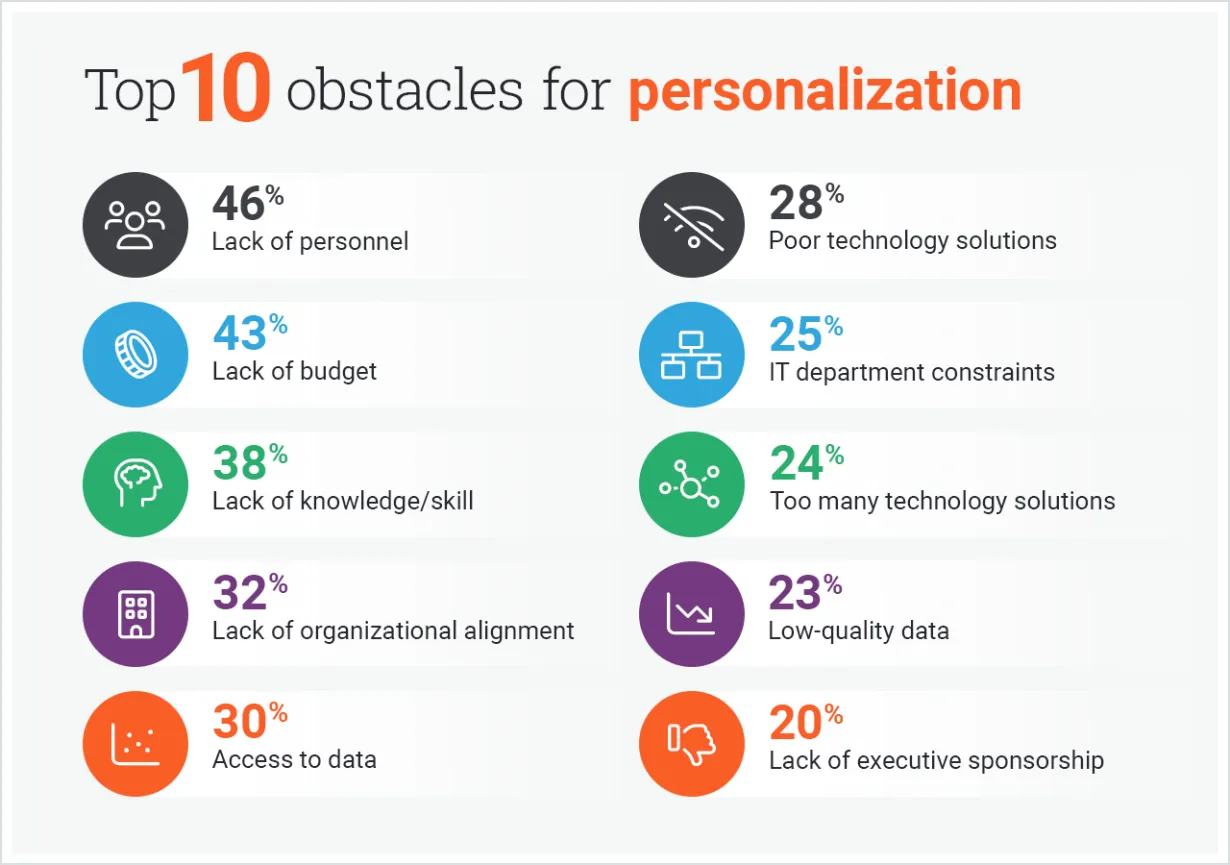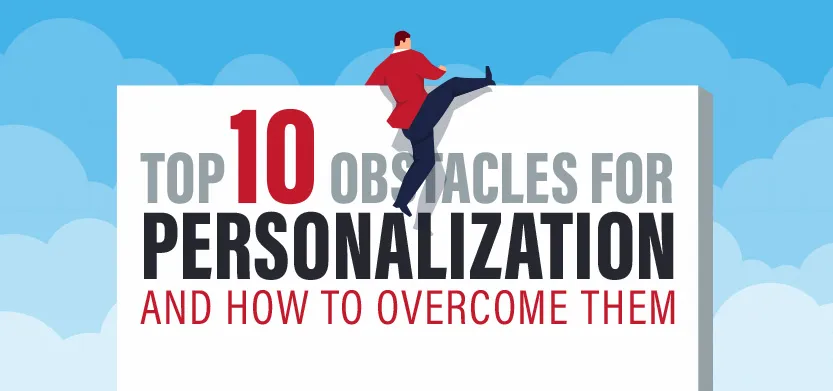

Posted in Digital Commerce, Personalization
December 14, 2022
Top 10 obstacles for personalization & how to overcome them
A research report on personalization by Researchscape International and Evergage has identified the top 10 obstacles that B2B and B2C ecommerce companies face. In this article, Mike Hubbard outlines what they are and the source of most personalization pain points.
Personalization pain points, by percentage:

Source: 2019 Trends in Personalization Survey Report, Researchscape International and Evergage, Inc.
Catch the podcast
Listen to this post using the player, or subscribe using Spotify, Apple Podcasts, or Google Podcasts.
Personalization is no longer just a buzzword but a critical part of online marketing and sales strategies for increasing sales and customer satisfaction by creating a more personal customer experience. Many studies have come out over the years to validate this, including this recent 2019 report by Researchscape International and Evergage Inc. that surveyed over 300 marketing professionals from B2C and B2B digital commerce companies to try to understand the typical thoughts and trends surrounding personalization. The survey summarized these marketing professionals' feelings toward incorporating a personalization strategy into their practices.
Marketers overwhelmingly agree (98%) that personalization helps advance customer relationships, with 70% claiming it has a “strong” or “extremely strong” impact. And 85% state that their customers and prospects expect a personalized experience.1
While the respondents have indicated the importance of personalization, they also say there are significant challenges in implementing their personalization strategies.
- When asked, "are marketers getting personalization right"?
- Only 32% of the respondents agreed.
- When asked, "how would you rate your organization's personalization maturity"?
- Only 9% felt they were advanced, with just 1% feeling they were best-in-class1.
As we can see, the overall sense is that there is still much room for improvement.
In this post, I'll go over the personalization implementation challenges indicated by survey respondents and offer my opinion on how they can be overcome. Let's get to it.
Why do ecommerce companies struggle with personalization?
Respondents were asked to select one or more answers from a list for "what are the greatest obstacles to making personalization a bigger priority in your organization?"
Here are the top 10 obstacles based on the percentage of respondents that selected them.
- Lack of personnel — (46%)
- Lack of budget — (43%)
- Lack of knowledge/skill — (38%)
- Lack of organizational alignment — (32%)
- Access to data — (30%)
- Poor technology solutions — (28%)
- IT department constraints — (25%)
- Too many technology solutions — (24%)
- Low-quality data — (23%)
- Lack of executive sponsorship — (20%)1
Making a case for personalization
The top four options (and also number 10) are all budget and strategy issues. If you lack the budget or need to add people/knowledge internally or via a third-party service provider, all these have a cost. Without buy-in from stakeholders, the budget won't be made available to pursue a personalization strategy at a higher capacity. So how do you get funding and buy-in? Justify your case that an increased budget to execute your personalization strategy will increase revenue. Then follow up with some accurate reporting to validate your strategy.
Commerce architecture for aligning technology
The remaining five options are all based on utilizing all available data effectively. This is a technology issue where data and platforms are siloed and disconnected. We see this in the report when respondents were asked, "which of the following describes your company's approach to omnichannel personalization" 74% stated that they had less than half of their channels connected. Only three percent indicated that all channels were connected1.
The solution will benefit the business more than just personalization — commerce architecture.
Commerce architecture is what we use to describe the entire ecosystem of software and technology a business uses to conduct business, including sales, accounting, support, marketing, inventory, fulfillment, etc. The critical takeaway here is how well all the different components are integrated. If proper technology selection and integrations are in place, a foundation is built in which all the data you need is at your fingertips across all channels. By defining a commerce architecture strategy and working towards its full potential, best-in-class personalization capabilities are just one of the many valuable results.
Commerce architecture even plays into the other points, too. When a commerce architecture strategy is understood and accepted at all levels of business, executive sponsorship and organizational alignment are much easier to achieve. This is because it's easier to understand and communicate how data flows throughout the organization, including the impact each technological component has on the business. It's all about running efficiently with integrations and automation. A minimal bottom line supports business growth and scaling when a cohesive commerce architecture is achieved. The result is more capital to invest in strategic initiatives such as personalization. Suddenly, a budget might become available to get the personnel and knowledge that your personalization strategy needs. So really, commerce architecture, in my opinion, is the answer to overcome all 10 of the obstacles to personalization.
Set up for success: The link between personalization and commerce architecture
Elli.com, a web-to-print company providing personalized designer wedding stationery, was in a tight spot. Their business depended on a customer-facing personalization tool that allowed their customers to add the finishing touches to wedding stationery designs. The problem was that this tool was nearing end-of-life, meaning Elli had to upgrade to a newer version or replace it with something else. The latest version had an increased cost of use, not to mention there had always been annoying usability and workflow issues that would persist after they upgraded. For the team behind Elli, it was time to look at other options.
After an initial discovery and strategy phase with Acro Commerce, Elli decided to revise their commerce architecture by swapping out the web-to-print personalization tool that had put them in this position in the first place and by migrating to a new ecommerce platform. Out with the old, in with the new.
The new personalization tool, Customer's Canvas, was better for what they needed. It provided their customers with an improved user experience and eliminated the usability issues they had previously experienced. Personalizing wedding stationery went from awkward and challenging to fun and intuitive. A wedding is one of life's most incredible personal experiences, but planning a wedding is stressful. Elli's advanced personalization of the shopping experience helps relieve some of the stress.
The new ecommerce platform, Drupal Commerce, also suited Elli's business goals better. The integration with Customer's Canvas was already created, so that part was easy. The new platform gave Elli the technical flexibility their growing business needed to optimize their workflows and web-to-print process further, integrating directly with their printing partner. Site administrators now have a more enjoyable backend environment to work within, making managing custom products easier. Elli's leadership team is now better positioned to scale the business efficiently, supported by an improved commerce architecture.
Next steps for your personalization strategy
Digital commerce architecture is a big part of what we do at Acro Commerce, both in consultation and implementation. While we might not be the ones to take your personalization strategy to the next level, we're the ones who can help you get your technology aligned and working for you so that your team can do what it needs. If you like what you're hearing and want to explore commerce architecture further, scroll through the various articles on Acro Commerce's resource page. Take a look at our digital commerce services page, and drop us a line if you want to talk.
If you're pumped about personalization and looking for ideas for your personalization strategy, check out this article titled Personalization: Different Types and How They're Used in Ecommerce. It will give you a good high-level overview of what's possible.
1 — Source: Researchscape International and Evergage, Inc., "2019 Trends in Personalization Survey Report," April 2019.
Editor’s note: This article was originally published on December 10, 2019, and has been updated for freshness, accuracy and comprehensiveness

